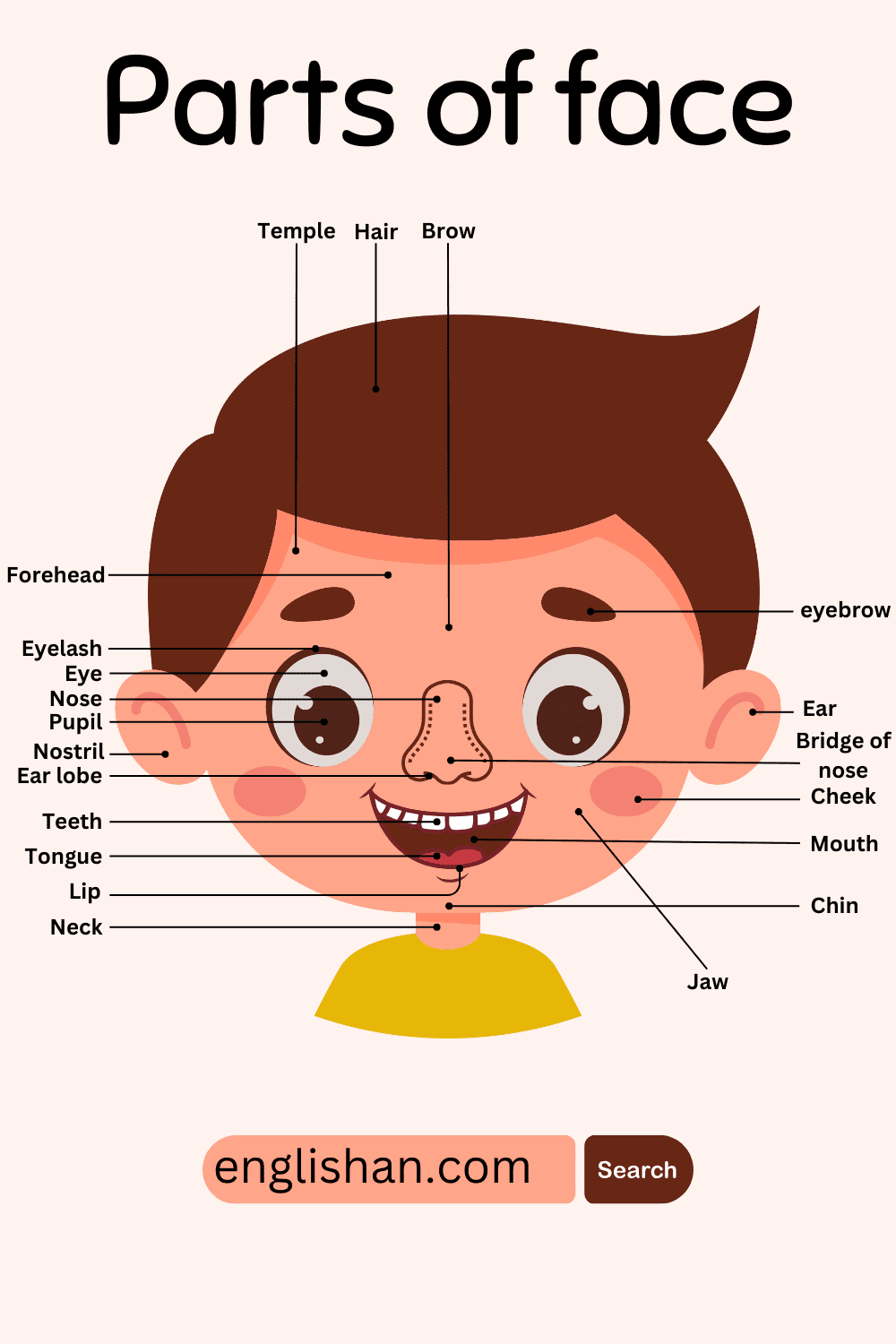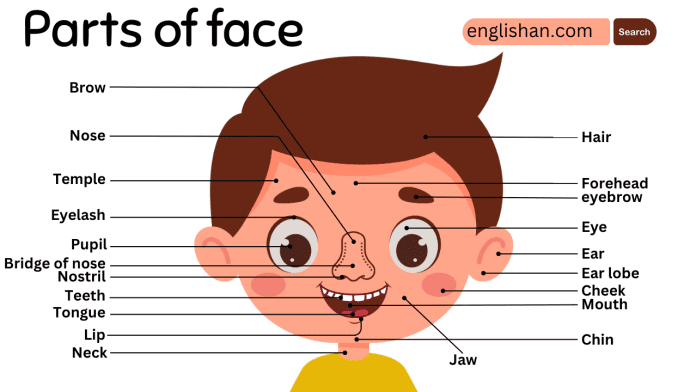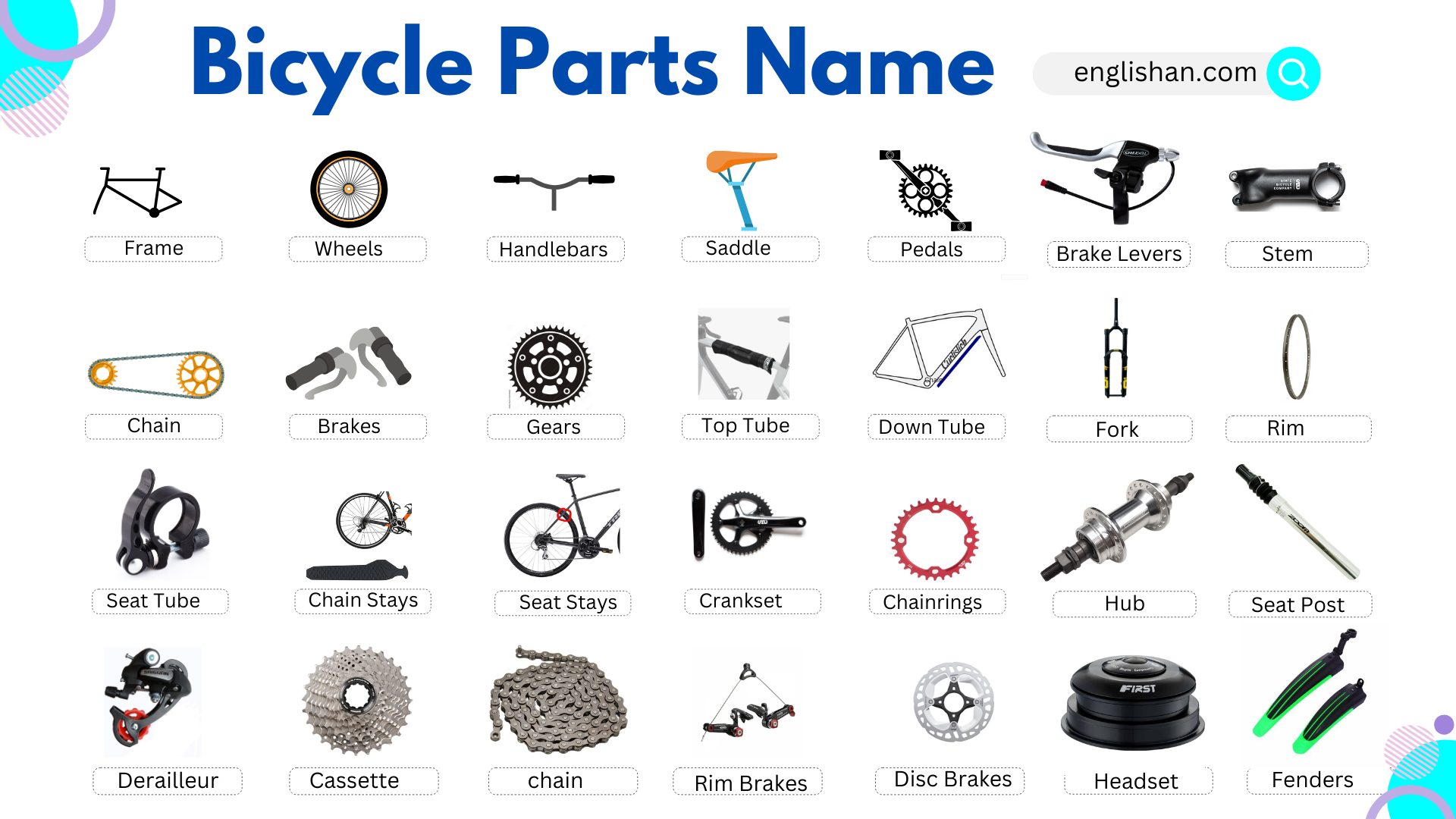Contents
In this blog post, you will learn the different parts of the face in English. Each part has a specific name that helps us describe people and their features clearly. Understanding these terms will improve your vocabulary and make communication easier. Whether you are studying for school or practicing English, knowing these words will help you describe faces accurately.
To learn more vocabulary on different topics, visit our Vocabulary Category.
Parts of Face
The face is a complex area of the head that comprises various features and structures. Here are the main parts of the face:
1. Forehead:
The upper part of the face, located above the eyes and below the hairline.
2. Eyes:
The organs of sight, set in the eye sockets or orbits.
3. Nose:
The central protruding part of the face that allows for breathing and contributes to the sense of smell.
4. Cheeks:
The fleshy areas on the sides of the face, below the eyes.
5. Mouth:
The opening in the lower part of the face used for speaking, eating, and breathing.
6. Lips:
The fleshy, movable parts around the mouth.
7. Chin:
The bottom and front part of the face, below the lower lip.
8. Jaw:
The lower part of the face that includes the lower jawbone (mandible).
9. Ears:
The organs of hearing, located on each side of the head.
10. Facial Hair:
Features such as beard, mustache, or eyebrows, vary in appearance among individuals.
11. Skin:
The overall covering of the face, including features like complexion and texture.

Frontal Parts of Face
Frontal parts of face refer to the structures and features located at the front portion of the head. Here are the key frontal parts of the face:
- Forehead: The upper part of the face, extending from the eyebrows to the hairline.
- Eyes: The organs of sight, positioned in the eye sockets or orbits.
- Eyebrows: The hair-covered arches above the eyes.
- Eyelids: The movable covers that protect and control the exposure of the eyes.
- Eyelashes: Short hairs that grow along the edges of the eyelids.
- Nose: The central part of the face that protrudes, involved in breathing and smelling.
- Cheeks: The fleshy areas on the sides of the face below the eyes.
- Mouth: The opening used for speaking, eating, and breathing.
- Lips: The soft, movable parts surrounding the mouth.
- Chin: The bottom and front part of the face, below the mouth.
These frontal parts collectively contribute to the facial expression, communication, and sensory functions of the face. They also play a significant role in conveying emotions and expressions through movements and features in this area.
Side and Lower Face Parts
Side and lower parts of the face contribute to the overall structure and expression of an individual. Here are the key components:
- Cheeks: The fleshy areas on the sides of the face, below the eyes. Cheeks contribute to facial fullness and expressions.
- Jawline: The area along the lower edge of the jaw, defining the contour of the lower face.
- Jaw: The lower part of the face, including the jawbone. It plays a role in chewing and facial symmetry.
- Chin: The bottom and front part of the face, below the mouth. The chin contributes to the overall facial profile.
- Neck: The portion connecting the head to the body. The neck is essential for head movement and supports the weight of the head.
- Ears: Organs of hearing, located on each side of the head. Ears contribute to the overall facial symmetry.
These side and lower face parts, along with the frontal parts, work together to create a person’s unique appearance. The combination of features in these areas influences facial expressions, communication, and individual characteristics.
Auxiliary Features
While these facial features might not immediately catch your attention, they significantly contribute to the overall facial landscape. Acquainting yourself with these elements will enhance your vocabulary toolkit for describing facial characteristics.
Care
Face care, also known as skincare, involves a set of practices and products aimed at maintaining the health, cleanliness, and appearance of the facial skin. Here are key aspects of a basic face care routine:
- Cleansing: Use a gentle facial cleanser to remove dirt, oil, and impurities from your skin. Cleansing helps prevent breakouts and keeps your skin fresh.
- Exfoliating: Exfoliate your skin a few times a week to remove dead skin cells and promote cell turnover. This can be done using a scrub or a chemical exfoliant.
- Moisturizing: Apply a moisturizer to keep your skin hydrated. Choose a product that suits your skin type, whether it’s oily, dry, combination, or sensitive.
- Sun Protection: Use sunscreen with at least SPF 30 to protect your skin from harmful UV rays. Sunscreen helps prevent sun damage, premature aging, and reduces the risk of skin cancer.
- Eye Care: Consider using an eye cream to address specific concerns like dark circles or puffiness. Gently apply the product around the eyes.
- Serums and Treatments: Use targeted serums or treatments for specific skin concerns, such as acne, hyperpigmentation, or fine lines.
- Hydration: Drink plenty of water to keep your skin hydrated from the inside out. Staying well-hydrated supports overall skin health.
- Balanced Diet: Eat a balanced diet rich in vitamins and antioxidants. Nutrient-rich foods contribute to healthy skin.
- Adequate Sleep: Ensure you get enough sleep. Quality sleep is crucial for skin repair and rejuvenation.
- Gentle Makeup Removal: If you wear makeup, use a gentle makeup remover or cleansing oil to remove it before bedtime.
Avoiding Mistakes
Avoiding common skincare mistakes is crucial for maintaining healthy and radiant skin. Here are some tips to help you steer clear of these pitfalls:
- Over-Cleansing: Avoid over-cleansing your face, as excessive washing can strip away natural oils, leading to dryness and irritation. Stick to a gentle cleanser and wash your face twice a day.
- Skipping Sunscreen: Neglecting sunscreen is a major mistake. Always apply sunscreen with at least SPF 30, even on cloudy days. Sun protection helps prevent premature aging and reduces the risk of skin cancer.
- Using Harsh Products: Be cautious with harsh skincare products that may contain strong acids or abrasive particles. These can irritate the skin and exacerbate existing issues.
- Not Patch Testing: Before incorporating new skincare products, patch test them on a small area to check for any adverse reactions or allergies.
- Picking at Skin: Resist the temptation to pick at acne or blemishes, as it can lead to scarring and further inflammation. Use targeted acne treatments instead.
- Ignoring Skin Type: Understand your skin type (dry, oily, combination, sensitive) and choose products accordingly. Using products not suited to your skin type can lead to issues.
- Inconsistent Routine: Consistency is key in skincare. Stick to a routine and give products time to show results before making changes.
- Not Hydrating Enough: Hydrate your skin by drinking enough water and using a good moisturizer. Dehydrated skin can lead to dullness and increased sensitivity.
- Overlooking Diet: A balanced diet with nutrients like vitamins and antioxidants is essential for healthy skin. Avoid excessive consumption of processed foods and sugars.
- Stress Management: Manage stress, as chronic stress can negatively impact your skin. Practice relaxation techniques and ensure adequate sleep.
Parts of Face Exercises
1. What is the organ of sight?
a) Nose b) Eyes
2. Where is the philtrum located?
a) Forehead b) Between the nose and upper lip
3. Which part is associated with facial expressions and emotions?
a) Cheeks b) Mouth
4. What are the small, dark spots on the skin that can be flat or raised?
a) Moles b) Freckles
5. Where are the tear ducts located?
a) Near the ears b) Near the inner corners of the eyes
6. What is the protrusion in the throat, more prominent in males?
a) Chin b) Adam’s Apple
7. Where do you find the cleft chin?
a) On the forehead b) On the lower part of the face
8. What is the primary organ of hearing on the face?
a) Nose b) Ears
9. What do you call the fine lines or creases on the skin, often due to age or expressions?
a) Pimples b) Wrinkles
10. Which part is responsible for breathing and smelling?
a) Eyes b) Nose
11. What is the small line or crease that runs from the sides of the nose to the corners of the mouth?
a) Nasolabial Fold b) Jawline
12. Where can you find eyelashes?
a) On the chin b) Along the edges of the eyelids
Answers:
- b) Eyes
- b) Between the nose and upper lip
- b) Mouth
- a) Moles
- b) Near the inner corners of the eyes
- b) Adam’s Apple
- b) On the lower part of the face
- b) Ears
- b) Wrinkles
- b) Nose
- a) Nasolabial Fold
- b) Along the edges of the eyelids
FAQs
The main parts of the face include the forehead, eyes, nose, cheeks, mouth, lips, chin, jaw, ears, and neck.
The forehead is a prominent facial feature and plays a role in overall facial aesthetics. It also contributes to expressions and can be a site for wrinkles.
Eyelashes help protect the eyes from debris and play a role in preventing irritants from entering the eyes.
The nose is not only crucial for breathing but also contributes to the sense of smell, and its shape can impact facial aesthetics.
Facial muscles and features like the eyes and mouth work together to express a wide range of emotions, from joy to sadness and surprise.
The jawline contributes to facial definition and contour. It is often associated with attractiveness and symmetry.
Ears are included in facial anatomy as they contribute to the overall symmetry and appearance of the face.
Lips are essential for verbal communication and expressing emotions through smiling, frowning, and other facial movements.
You May Also Like






